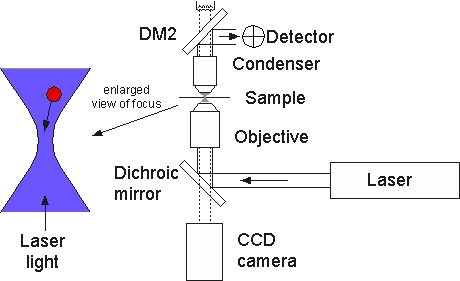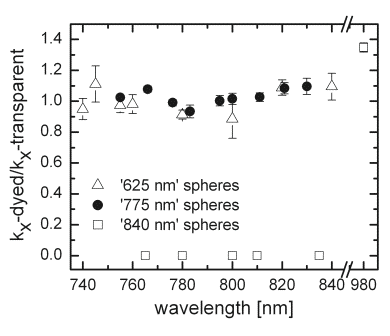Force measurements on resonant particlesThe primary goal of this research project is to find particles that behave like atoms in a tweezer trap, in the sense that the optical trapping force is strongly enhanced when the wavelength of the trapping laser is tuned close to the resonance transition of the particle/atom. To explore the possibilities of resonance-enhanced optical trapping, we have conducted experiments with polystyrene spheres doped with various dyes and performed numerical calculations of the trapping forces. The aim of these experiments and calculations is to study the additional force contributions from the resonance of the dye that is added to spheres, in particular, the wavelength dependence. These spheres are a model system to quantitatively explore this resonance effect on the trapping force as they have been used extensively in optical tweezers, and the forces on transparent polystyrene spheres are well understood. Our experimental and numerical results suggest, however, that a dye resonance does not provide a significant increase in the trapping force at wavelengths near resonance. This project is a collaboration with Prof. Ostroverkhova (OSU Physics). References:
|
|
|
The optical tweezer trap is an inverted optical microscope with a large numerical aperture objective that tightly focuses an incoming laser beam. The trapping laser is expanded to overfill the back aperture of the 160-mm tube length oil immersion objective. The Brownian motion of a particle in the trap is measured using a Quadrant Photo Detector (QPD). The QPD collects laser light scattered from the trapped particle and produces a signal proportional to the particle's displacement from the trap center. The QPD signal is analyzed to obtain spring constant values. |
 |
| Data from the experiment with a 2.0 micron sphere is shown at right. A portion of the time series of the particle displacement is shown in the upper left and the other plots show different ways of analyzing the data to determine the trap spring constant k. Near the center of the trap, the optical force is approximately linear, producing a spring-like linear force F = -kx, and a quadratic potential V = kx2/2. The fluctuation of the particle position is used to calculate the trap spring constant through the equipartition theorem. A histogram of the particle position is shown in the upper right and is fit to a Gaussian distribution that also depends on the spring constant. The Fourier transform of the time series position data is in the lower left. The 3-dB rolloff of the spectrum determines the spring constant in this case. The trap potential well profile determined from the position data is in the lower right, and is fit to a parabolic potential. All four estimates of the trap strength are consistent with each other, providing evidence that our trap is well characterized. |
 |
|
Experimental results for the measurements of the trap stiffness near resonance. The wavelength dependence of the trap stiffness values (k dyed) is shown for 625, 775, and 840 nm dye-doped polystyrene spheres, all normalized by those measured on transparent spheres (k transparent) under the same conditions. An enhancement in the trap stiffness is a value greater than 1. For the 625 and 775 nm spheres, variations of the trap stiffness were within 10% near resonance, which was within our experimental uncertainty. For the 840 nm spheres, a large effect due to the dye was observed, as no stable trapping could be achieved at 750-840 nm, but at 980 nm stable trapping was observed with a trap stiffness enhancement of about 35%. |
 |